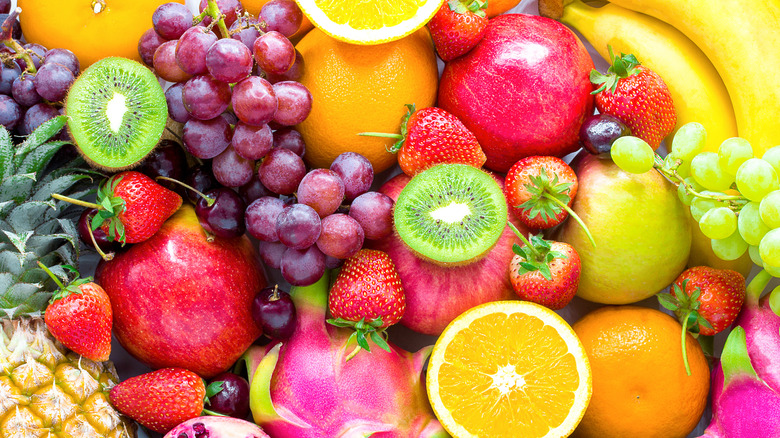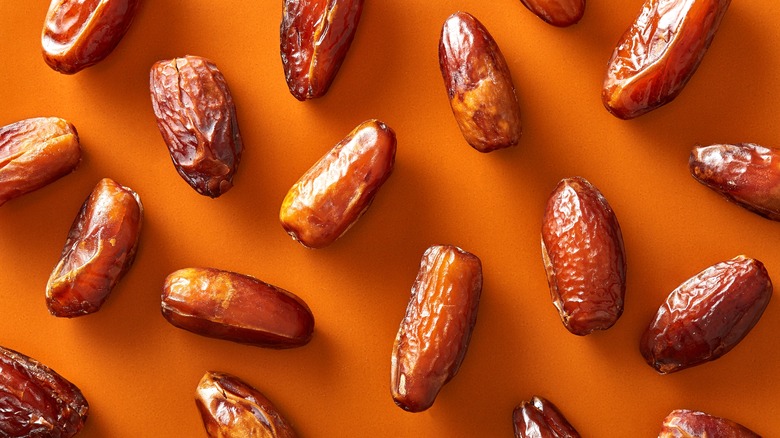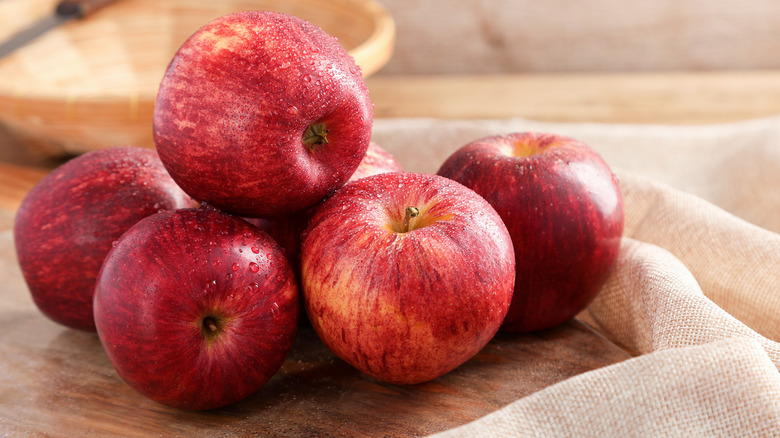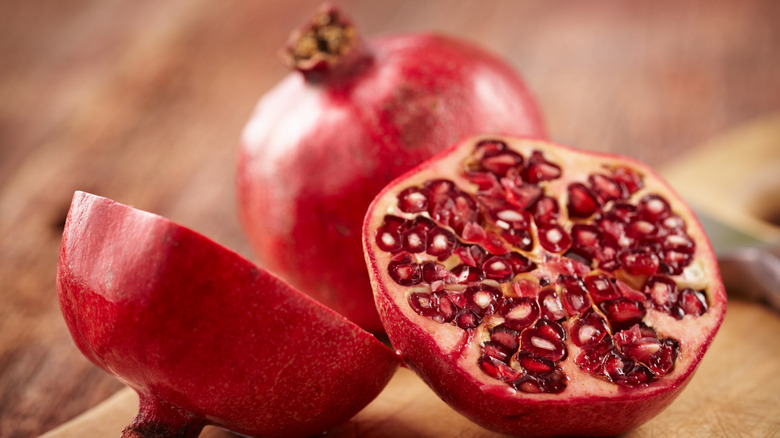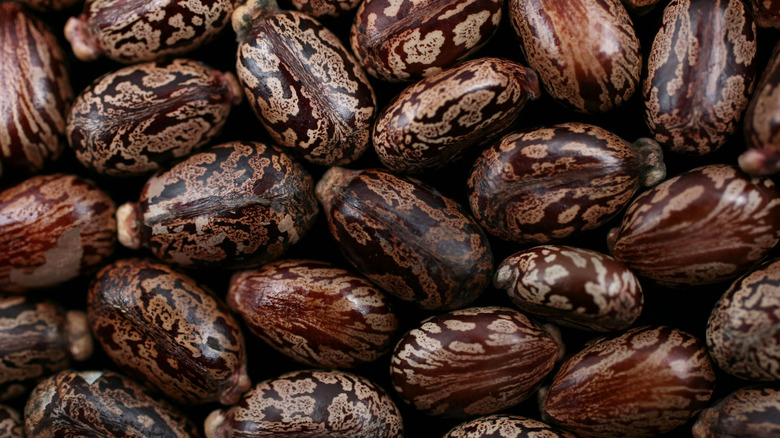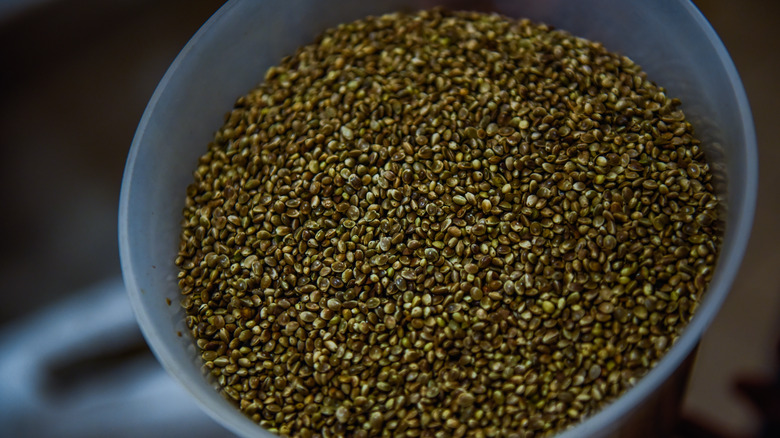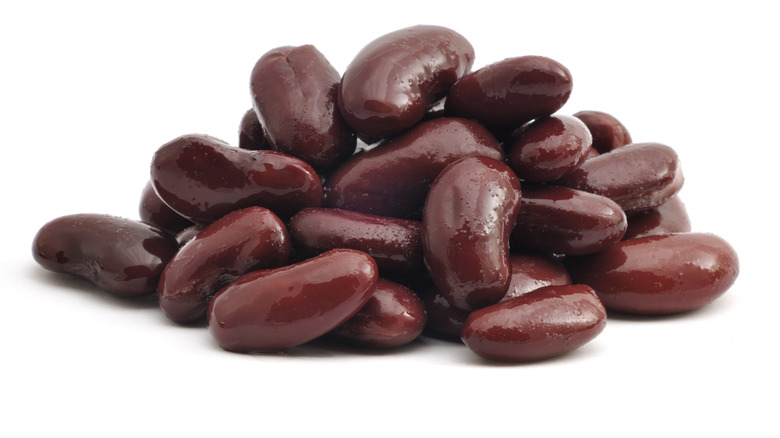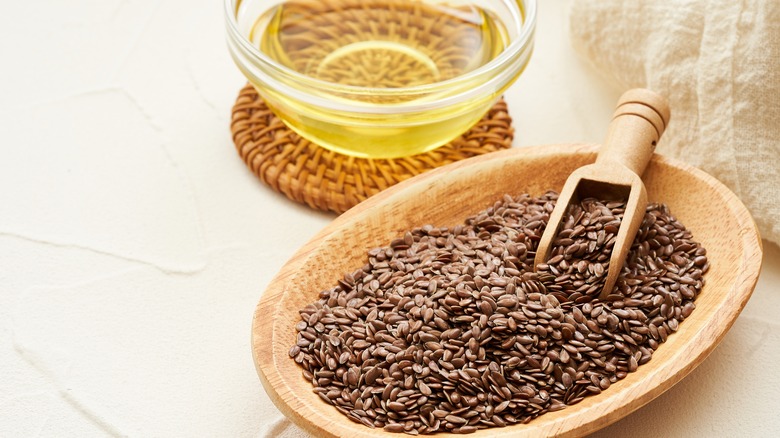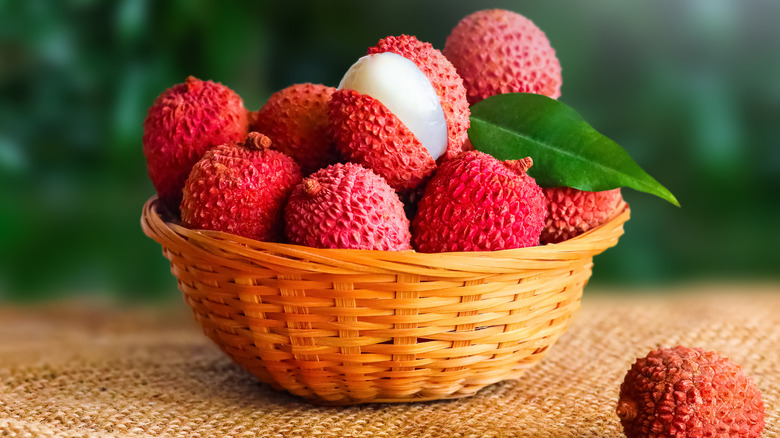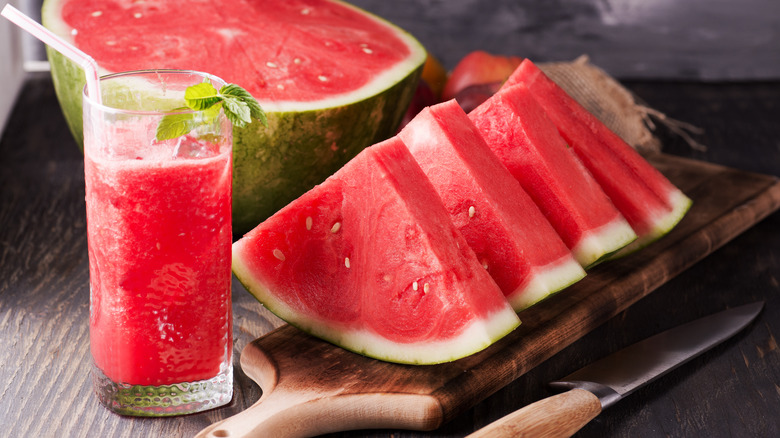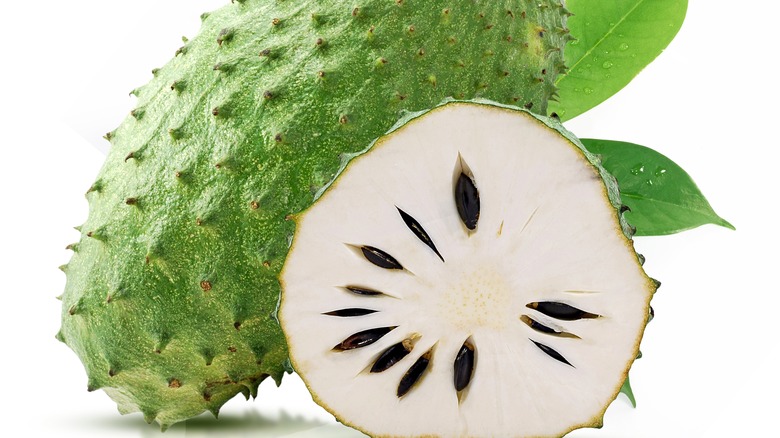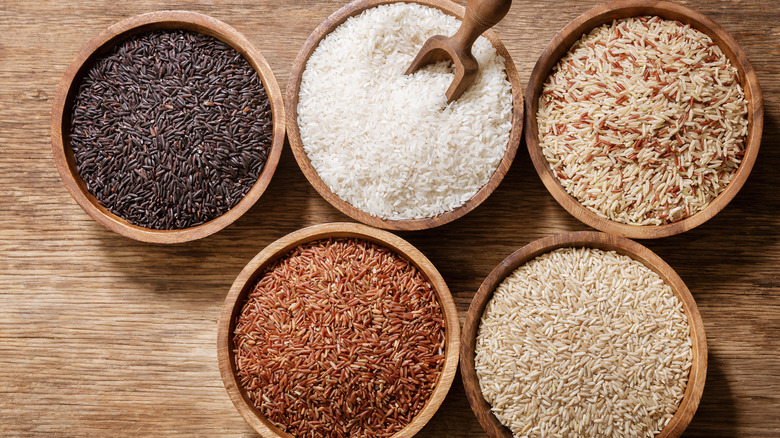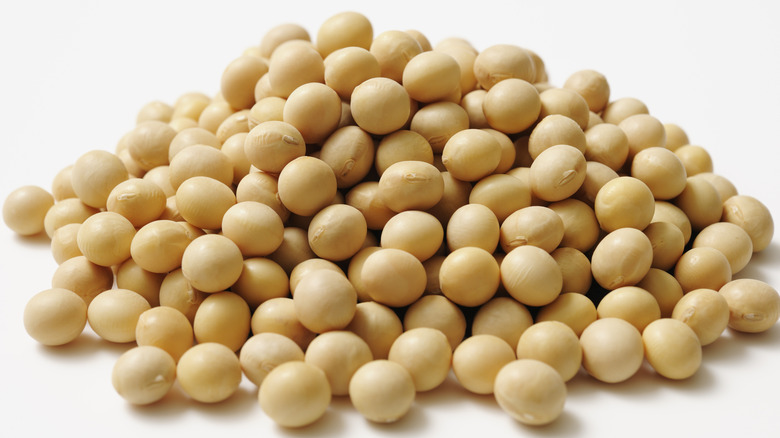6 Seeds You Can Safely Eat And 6 To Avoid
There are a wide variety of seeds, from tiny ones in bananas that are barely noticeable, to large ones (avocado or mango, anyone?) that you can't miss (and definitely shouldn't eat) — and practically every size in between. Some come in a hard cover like nuts, while others are tacked in pods.
Although uniquely packaged, seeds have one thing in common: They are loaded with nutrients to help new plants grow, which is precisely why a good number (think: sesame, chia seeds, and watermelon seeds) make a great addition to your diet. On the opposite side of the spectrum, some seeds are poisonous (apple seeds, castor beans, and lychee seeds come to mind).
Safe seeds have a myriad of benefits, including promoting a healthy heart, reducing cholesterol levels, and strengthening the immune system. Conversely, unsafe seeds can have devastating consequences: seizure, coma, or even death.
So, where do you draw the line when incorporating a seed-rich diet? Stay with us as we solve the puzzle of safe vs. unsafe seeds.
Safe: Date seeds
Dates are luscious fruits widely found in the middle east. Many enjoy the toffee-like flesh and throw out the date pits, unknowingly missing an equally nutritious part of the fruit. Date pits boast impressive amounts of dietary fiber, 60 to 80 grams per 100 grams (per Frontiers). They also have considerable amounts of carbohydrates, antioxidants, protein, and bioactive polyphenols.
Dietary fiber is essential for overall health and wellness. It helps maintain weight, regulates blood sugar, aids bowel movement, and lowers cholesterol levels. Antioxidants are known to fight free radicals that cause oxidative stress, hence minimizing cell damage. Proteins are bodybuilding, and carbohydrates give you the energy you need to stay active. Put another way; date seeds have an ample amount of nutrients you need to stay healthy.
The best way to consume date seeds is to roast and grind them into powder. Date seed powder is quite versatile. You can add the powder to your baked goods, including cookies, cakes, biscuits, muffins, or bread. The powder increases fiber content and prevents baked products from spoiling quickly. You can also use roasted date seed powder as a substitute for coffee. Brew your coffee by only adding the powder, or amplify the taste by adding spices, herbs, or even milk. Date seed powder beverages taste almost the same as coffee, except they don't have caffeine.
Avoid: Apple seeds
Fruits in the Rosaceae family — apples, cherries, peaches, pears, plums, apricots, and peach — have one thing in common: high amounts of amygdalin, which morphs into hydrogen cyanide when crushed (read: chewed) or damaged. Hydrogen cyanide is poisonous, with mild side effects ranging from dizziness, confusion, headache, anxiety, and low blood pressure which can escalate to life-threatening conditions like paralysis, coma, and even death when ingested in considerable amounts. Hydrogen cyanide inhibits cells from taking oxygen (via the University of Leeds).
Most varieties of apples produce 1 to 4 milligrams of Amygdalin per gram of apple seeds, which translates to roughly 0.6 milligrams of hydrogen cyanide. Deadly hydrogen cyanide poisoning occurs when you consume around 50 to 300 milligrams, which would take a considerable number of apple seeds. But that doesn't mean chewing several apple seeds won't make you sick. Remember we mentioned the mild side effects of hydrogen cyanide? That's your cue to avoid blending apples with their seeds.
However, if you mistakenly swallow a few seeds, you don't need to choke yourself to throw up. Since the seeds are coated, they'll pass through your digestive system without posing any harm. And now you are thinking, what about commercially processed apple juice? Well, a research study revealed a very low quantity of amygdalin in apple juice to cause harm — 0.01 to 0.04 milligrams per milliliter.
Safe: Pomegranate seeds
The edible part of pomegranate fruit is the seeds known as arils. Arils are packed with nutrients: antioxidants, fiber, vitamins, and minerals. Minerals play a vital role in ensuring strong bones and teeth. Vitamins strengthen the immune system and support the formation of blood vessels, cartilage, and bones.
Fiber plays a crucial role in ensuring a healthy gastrointestinal system. Further, it's linked to reduced risk of cardiovascular diseases, blood sugar regulation, and weight management. And here's what's amazing about antioxidants: They balance free radicals in the body.
You can scope the seeds straight from the flesh and eat them. They also make an excellent addition to a variety of foods because of their unique flavor. You can combine arils with other fruits to create a drool-worthy smoothie or extract its liquid and make a refreshing juice. Even better, add the seeds to your cereal bowl, or yogurt. They are also perfect for ice cream, pudding, and cheesecake toppings. That's not all — arils can elevate your salad bowl by mixing them into your favorite fruit or veggie salad. Finally, make a delightful drink by adding arils to your margarita, tequila, or a variety of cocktails.
Avoid: Castor bean seeds
At the mention of castor seeds, the first thing that comes to mind is castor oil. And you are right! Castor seeds are the raw material used to produce castor oil, even though the unhulled bean contains a lethal substance known as ricin. Fortunately, in oil production, the seeds undergo several processes to remove the ricin.
Ricin imposes high risk when consumed because when it gets access to the cells, it hinders them from producing protein required to conduct their normal function. This leads to cell death, which can be fatal. Whereas swallowing whole unhulled castor beans imposes less risk, you'll still need medical attention. The immediate side effects of chewing unhulled seeds include nausea, vomiting, diarrhea, dehydration, and abdominal pain. This can quickly culminate into liver, kidney, and pancreas damage, blood cell damage, seizure, shock, and ultimately, death. Taking four to eight beans for adults and three for children can cause deadly ricin poisoning.
According to the Centers for Disease Control and Prevention (CDC), inhalation of ricin is equally poisonous and can cause breathing difficulty, which could lead to death. The center further reveals that it takes 36 to 72 hours for death to occur through ricin poisoning. The exact duration will depend on whether you chewed the seeds, inhaled the powder, or rubbed it on your skin or eyes. Further, the quantity consumed determines the severity of the poisoning.
Safe: Hemp seeds
Hemp is a cannabis sativa, just like marijuana. However, THC, which accounts for the high in marijuana, is negligible in hemp. Hence, you can't get high by consuming hemp. Hemp seeds are brown, but the real gem lies inside the kernel. Bursting the seed open exposes the hemp heart, where all the nutrients lie.
Hemp heart is rich in protein, containing all nine essential amino acids. And since our bodies can't produce them, you are in for a nourishing treat. It gets better: These small yet mighty seeds are also loaded with fiber, zinc, magnesium, thiamine, and monounsaturated and polyunsaturated fats. Given their nutritional value, including hemp seeds in your diet may help alleviate the side effects of menopause. They also promote a healthy heart and improve digestion. And hemp seed oil helps with the symptoms of eczema, though experts are still conducting research regarding this specific use (via Medical News Today).
When it comes to consumption, you can increase your protein intake by sprinkling these seeds into your smoothie, cereal, yogurt, salad, stew, or soup. And since they are small, hemp seeds are an excellent addition to baked goods like cakes or muffins. You can stretch the seeds further and mix them with water, blend, and sieve to get hemp seed milk, which can be a substitute for dairy milk. Additionally, you can grind hemp seeds and use the powder in your recipes — for example, substitute it for bread crumbs when coating fish or chicken.
Avoid: Raw kidney beans
While when properly cooked kidney beans are an excellent source of plant protein, the raw bean is quite toxic. Kidney beans, like other legumes, contain phytohaemagglutinin, which in small amounts is harmless — the case for other beans. However, the quantity of phytohaemagglutinin in raw kidney beans is considerably high, which makes it toxic.
Eating four to five raw kidney beans is enough to cause havoc. In the next one to three hours after consumption, you'll most likely experience nausea, diarrhea, vomiting, and abdominal pain, which can dissipate after three to four hours from when the symptoms start. Sometimes, the affected would need medical attention to relieve the symptoms. The good news, however, is that raw kidney beans are not fatal.
A study revealed that it's best to soak kidney beans for five hours and drain the water before boiling the beans in clean water for not less than 10 minutes at 212 degrees Fahrenheit. The FDA recommends 30 minutes of cooking time for kidney beans to reach the recommended temperature and destroy phytohaemagglutinin. Cooking the beans in low heat doesn't eliminate the toxicity, as the beans won't reach the required temperature to kill phytohaemagglutinin.
Safe: Flaxseeds
Flaxseeds have taken the nutritional world by storm. Though small, these tiny super seeds are jam-packed with fiber, protein, carbohydrates, omega-3 fatty acids, thiamine, and several other minerals. This explains why you'll find them in several forms: seeds, powder, supplement, flour, capsules, oil, and tablets.
Firstly, flaxseeds contain a type of omega-3 fatty acid known as alpha-linolenic acid (ALA). ALA helps reduce the risk of cardiovascular diseases by preventing cholesterol accumulation in the heart vessels (per Advances in Nutrition). Additionally, ALA has anti-inflammatory properties that may be instrumental in reducing pain associated with arthritis. Secondly, the high fiber content is great for weight management, as you feel full longer after eating flaxseeds. Further, fiber promotes bowel movement, preventing constipation. Thirdly, flaxseeds contain lignan, which has been found to reduce the risk of particular types of cancer and chronic diseases (via Molecules).
You can enjoy this superfood in many ways. Start with sprinkling a spoonful or two into your smoothie, yogurt, or a bowl of oatmeal. They are also excellent additions to sandwiches, burgers, and pancakes. It doesn't end there: Add flaxseeds to your stew or soup, and even blend into a cake mixture. Better yet, substitute your usual breadcrumbs for flaxseeds when coating chicken.
Avoid: Lychee seeds
Lychee is a fruit native to Asia. It can be traced back 2,000 years to China and Vietnam. The ripe lychee fruit, which has spread to several parts of the world, is highly nutritious. However, lychee seeds are toxic — they contain methylene cyclopropyl-alanine (MCPA) and methylene cyclopropyl-glycine (MCPG), according to Nutrients. These two toxins are linked to hypoglycemic encephalopathy (extremely low blood sugar in the body that may cause coma). The toxins hinder the production of glucose in the body (via Emerging Infectious Diseases).
Hypoglycemic encephalopathy can cause death in extreme situations where the consumer is malnourished or has been fasting, as was the case in the death of 31 children in India – the same toxins in the seeds are found in unripe lychee fruits. Lychee seed poisoning is deadly on an empty stomach since your glucose levels are already low. Eating kernels or unripe fruits lowers the glucose levels further. Lychee seeds' signs of poisoning include loss of consciousness, convulsion, and brain swelling. To be on the safe side, never eat unripe lychee. And when eating ripe ones, remove the seeds first.
Safe: Watermelon seeds
Most people barely notice the brown seeds embedded in the flesh when eating watermelon. Understandably, the luscious red-pink flesh is so enticing you won't want to waste another second contemplating eating or not eating the seeds. But here's the thing: Watermelon seeds are full of nutrients.
These tiny brown powerhouses are rich in minerals, including magnesium, zinc, iron, calcium, phosphorus, and potassium. They also contain proteins, fat, folate, and carbohydrates. Magnesium reduces the risk of diseases like diabetes, cardiovascular diseases, migraines, bronchial asthma, osteoporosis, and preeclampsia (via the International Journal of Endocrinology). Iron makes hemoglobin, while zinc ensures a robust immune system and cell development and growth.
Instead of spitting the seeds out when eating watermelon, chew them along with the flesh. But if you want to boost the flavor, roast the seeds before adding them to your recipes. Watermelon kernels are versatile – you can have them as toppings on your ice cream, yogurt, or oatmeal. Further, you can grind the seeds to get watermelon seed powder. Sprinkle the powder on your porridge, soup, or juice.
Avoid: Custard apple seeds
Custard apple seeds have been used for centuries to remove lice in the hair and for facial skin care, where it does a great job except when it gets in contact with the eyes. According to a study, when the eyes come in contact with custard apple seed powder, victims experience irritation, severe pain, redness, watering, eyelid swelling, and photophobia (via the Indian Journal of Ophthalmology). As per the study, "active compounds such as alkaloids, cyclohexapeptides, and acetogenins contained in the seeds cause abnormality in epithelial integrity."
The study further revealed that exposure to custard apple seeds powder causes corneal erosion and abrasions, conjunctival irritation, and ulcers of the eyes. Within six to 12 hours, the toxicity can lead to toxic keratoconjunctivitis. The Indian Journal of Ophthalmology also notes the toxicity could spiral to microbial keratitis if treated with the wrong medication. Even worse, one could go blind if the custard apple seeds' juice comes into contact with the eyes. Despite its toxicity, accidentally swallowing a kernel won't pose any danger, as it's still intact. But, avoid using custard seed powder for hair treatment or skin exfoliation, as accidental exposure to the eyes can occur.
Safe: Wild rice
Although many assume that wild rice is in the rice family, it isn't. And yes, it looks like rice and is often cooked like one. However, it's the seeds of grass that grow along lakes and river banks, and marshy areas in North America and Asia. Wild rice can be traced back to Native Americans. But it has made its way into the mainstream market because its nutritional benefits can no longer be downplayed (per the U.S. Department of Agriculture).
Wild rice is brimming with fiber, proteins, minerals, and antioxidants. It provides the same amount of fiber as brown rice but outshines white rice (cooked wild and brown rice have 1.8 grams fiber per 100 grams while white rice has less than 1 gram fiber for the same serving). Although the quantity of protein in wild rice (4 grams per 100 grams) is not as much as in well-known protein-rich foods, the amount is considerably higher than in white and brown rice. Even more importantly, wild rice contains all the essential amino acids required for complete proteins.
You can cook wild rice alone. But given its overpowering taste and exorbitant price, consider adding it to your pilaf — the most common wild rice recipe. Wild rice takes a considerable amount of time to cook, around 45 minutes. So, give it ample time. Other recipes where wild rice can be a great addition include stews, soups, and salads.
Avoid: Raw soybeans
Raw soybeans contain lectin, saponins, and protease inhibitors, which are bad for your health. The health problems posed by these toxins can last for a short time or drag on for years, as it all boils down to the amount consumed and personal tolerance.
Unfortunately, cooking doesn't destroy saponins. It's the culprit behind the hint of bitter taste found in soybeans. Mild side effects of saponins may include nausea, vomiting, gas, abdominal pain, and diarrhea. According to the Food Production, Processing and Nutrition journal, when consumed in large amounts, saponin limits the function of some digestive enzymes, interfering with the digestion process, which could lead to indigestion complications. Further, it inhibits the absorption of vitamins A and E and lipids and causes hemolysis.
The same study in the FPPN journal reveals that lectins attach themselves to cells in the gastrointestinal system, hindering the optimum absorption of food nutrients into the small intestine. It also affects pancreatic cells and limits growth. The protease inhibitors limit enzymatic function. Therefore, to neutralize the impact of these three components, it's essential to boil soybeans until they are well-cooked.

